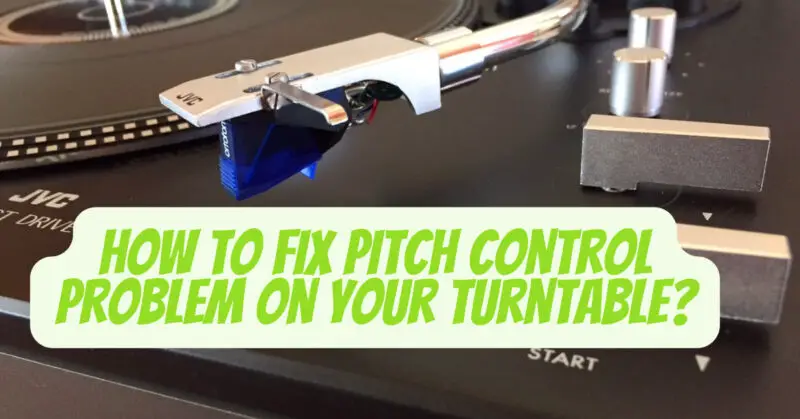If you’re having a pitch control problem on your turntable, don’t over worry as its quite a common issue audiophiles face. We’ll look at some ways to fix the problem and also understand why this pitch control problem occurs.
To fix the pitch control on your turntable, follow these 5 steps:
- Clean the pitch control potentiometer (fader) with contact cleaner, as dirt and grime can cause scratchy and unreliable operation.
- Check the wiring to the pitch control for loose connections or frayed wires, and repair if necessary.
- Calibrate the pitch control using a strobe disc, which will help you set the correct speed for the turntable.
- Check the turntable’s belt for looseness or signs of wear and replace if necessary.
- If the turntable has a ground wire, make sure it is securely attached to the phono preamp or amplifier, as this can cause issues with the pitch control.
If these steps do not resolve the issue, you may need to seek the services of a professional repair person or consider purchasing a new turntable.
Why does your turntable have this pitch control problem?
Turntable pitch control problems can occur due to a variety of reasons, including:
- contact cleaner (fader) – Dirt and grime can accumulate on the fader, causing scratchy and unreliable operation.
- Loose or frayed wiring – Over time, the wiring that connects the pitch control to the turntable can become loose or fray, causing problems with the pitch control.
- Calibration issues – If the pitch control is not calibrated correctly, it can cause problems with the speed of the turntable.
- turntable’s belt – The belt that connects the motor to the platter can become loose or show signs of wear, which can affect the speed of the turntable and cause issues with the pitch control. This usually is a common culprit causing the pitch control problem.
- Grounding issues – If the turntable has a ground wire, and it’s not securely attached to the phono preamp or amplifier, it can cause issues with the pitch control.
- Component failure – Over time, the components of the pitch control circuit can fail, which can cause problems with the pitch control.
These are some of the most common reasons why turntable pitch control problems can occur, but there may be other issues as well. If you’re unable to resolve the problem through cleaning or basic troubleshooting, you may need to seek the services of a professional repair person.
How does a Loose or worn belt cause issues with the pitch control of a turntable?
A loose or worn belt on a turntable can cause issues with the pitch control because it affects the speed at which the platter spins. The belt is what connects the motor to the platter and helps keep the speed of the turntable consistent. If the belt is loose, it can cause the platter to spin at a slower or faster speed than it’s supposed to, which can result in pitch control issues.
Similarly, if the belt is worn or stretched, it can cause the platter to spin at a slower or faster speed, which can also result in pitch control problems. This can be especially noticeable when trying to play music at a specific tempo, as the speed changes can cause the music to be out of time or out of tune.
To resolve these issues, you’ll need to replace the belt with a new one that’s the correct size and tightness. This should restore the correct speed and stability to the turntable and help resolve any pitch control issues.
Is pitch control necessary on a turntable?
Yes, pitch control is necessary on a turntable. Pitch control, also known as tempo control or speed control, allows you to adjust the speed of the turntable’s platter. This is important because it allows you to play records at the correct speed, which helps to ensure that the music is played in the correct tempo and in tune.
Without pitch control, the turntable would always play records at a fixed speed, which could cause the music to sound too fast or too slow. This can be especially noticeable when playing music that has a specific tempo, such as dance or electronic music.
In addition to ensuring that the music is played in the correct tempo, pitch control also allows you to make small adjustments to the speed to correct for variations in the speed of the turntable’s motor. This can help to ensure that the turntable stays in tune over time and reduces the chance of issues with the pitch control.
Overall, pitch control is an essential component of a turntable and is necessary for ensuring that your records are played at the correct speed and in tune.
If you’re a visual person, check out these youtube videos below:


